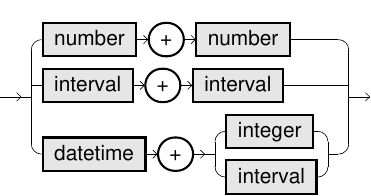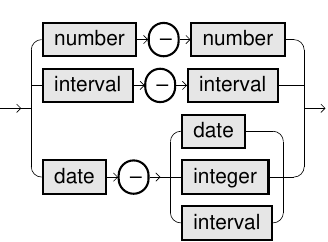Arithmetic operators perform mathematical operations on two values or more.
Syntax
+ operator::=

- operator::=

* operator::=

/ operator::=

Usage Notes
For '+' operator:
- If you add a decimal value to a timestamp, the result depends on the session/system parameter
TIMESTAMP_ARTITHMETIC_BEHAVIOR:- When
TIMESTAMP_ARITHMETIC_BEHAVIOR='INTERVAL'- the decimal is rounded to an integer, and a certain number of full days are added (this is similar to function ADD_DAYS).
- When
TIMESTAMP_ARITHMETIC_BEHAVIOR='DOUBLE'- the fraction of days are added (hours, minutes, ...).
- When
- When adding the number of years or months (for example,
INTERVAL '3' MONTH) on a date whose day is the last day of the month, then the last day of the resulting month is returned (similar to ADD_MONTHS).
For '-' operator
- The difference between two datetime values depends on the session/system parameter
TIMESTAMP_ARITHMETIC_BEHAVIOR:TIMESTAMP_ARITHMETIC_BEHAVIOR='INTERVAL'- the result is an interval (similar to function DAYS_BETWEEN).TIMESTAMP_ARITHMETIC_BEHAVIOR='DOUBLE'- the result is a double.
- The difference of a datetime value and a decimal is similar to the + operator with a negative value, thus subtracting days instead of adding them.
- The difference between two interval values return an interval.
- When subtracting the number of years or months (for example,
INTERVAL '3' MONTH) on a date whose day is the last day of the month, then the last day of the resulting month is returned (similar to ADD_YEARS and ADD_MONTHS).
Example:
SELECT 1000 + 234 ADD1,
DATE '2000-10-05' + 1 ADD2,
DATE '2009-01-05' + INTERVAL '1-2' YEAR TO MONTH ADD3,
100000 - 1 SUB1,
DATE '2000-10-05' - 1 SUB2,
DATE '2009-01-05' - INTERVAL '2' MONTH SUB3,
100 * 123 MUL,
100000 / 10 DIV;